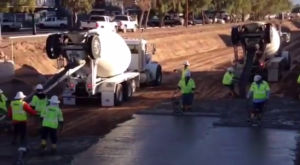What do Carp and Concrete Have in Common?
Answer: The SRP Canal dry-up Project
 I had always thought “the whole 9 yards” was somehow related to football. You know, like “3 yards and a cloud of dust.” But I recently learned that it is a concrete term. You see, the average capacity of a standard cement mixer truck is around 9 – 10 cubic yards. So when you need the whole load the expression is “the whole 9 yards.” It’s not how much you need for the next first down!
I had always thought “the whole 9 yards” was somehow related to football. You know, like “3 yards and a cloud of dust.” But I recently learned that it is a concrete term. You see, the average capacity of a standard cement mixer truck is around 9 – 10 cubic yards. So when you need the whole load the expression is “the whole 9 yards.” It’s not how much you need for the next first down!
What does that have to do with the SRP Canal dry-up project? Well that project requires several trucks with the whole 9 yards.
Each fall and winter, portions of the Salt River Project’s major canals north of the Salt River are dried up for about a month. This is so that maintenance and construction work can be completed on the dried up section.
During the dry-up trash and debris are removed from the canals. In some cases during these dry-ups both banks of the canal may be closed to the public to allow the required maintenance. These closures are to ensure public safety while the work takes place.
Why Dry-ups are Necessary
SRP is responsible for keeping the canal system in operating condition for normal water delivery. Canal dry-ups allow SRP, as well as other utilities and municipalities to perform construction and maintenance activities in and around the canals.
During these dry-ups portions of the canals are lined with cement like protective covering provided by Rock Solid, Inc. and other such concrete companies. This, of course, requires more than the whole 9 yards of several cement trucks. For the section of canal recently completed between 15th Avenue and 27th Avenue, Rock Solid provided about 5000 cubic yards of concrete. That much was required to cover the floor and walls of this section of the canal.
This project helps to minimize water loss through seepage into the ground.
Local governments also use the dry-up periods to do road work and other maintenance near the canals. Sometimes bridges are built or road ways are improved over and near the canals.
There’s Something Fishy here.
As you may know, the canals are filled with carp and other fish. Fishing on the canals is a popular pass-time. The dry-up of sections of the canals can cause severe problems for the fish. So SRP catches as many of the fish as possible and moves them to new, non-dry, locations during the clean up. For an interesting fish video go to
Recreation Restrictions and Safety.
As you might expect, recreational use of the canal and canal banks is restricted during these dry-up periods. In some cases both banks of the canal will be closed to the public to allow for the required maintenance. The closures are necessary to insure public safety while work on the canals takes place.
Dry-up Schedule.
Salt River Project performs dry-ups on a rotating sever-year schedule. Dry-ups are performed annually on canal sections south of the Salt River between mid-November and mid-December and on the north side of the Salt River between January and early February.
If you are interested, you may view a map of the seven-year dry-up plan. This map is for illustrative purposes and is subject to change without notice.
And that’s the whole 9 yards.